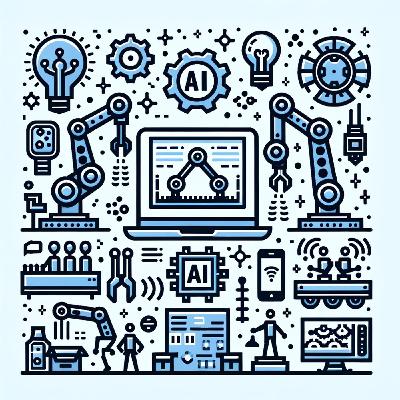Robo-Gossip: AI's Takeover Sparks Factory Frenzy!
Update: 2025-09-27
Description
This is you Industrial Robotics Weekly: Manufacturing & AI Updates podcast.
Industrial robotics is entering a new era marked by rapid advances in artificial intelligence, sensor technology, and automation, prompting manufacturers worldwide to rethink their production strategies for heightened efficiency, cost reduction, and adaptability. The International Federation of Robotics has projected an all-time high in industrial robot installations, with the global market value surpassing 16 billion United States dollars this year, and trends indicate this will keep accelerating as AI and machine learning redefine how manufacturers optimize production lines.
Factories are increasingly deploying AI-driven robots capable of predictive analytics, real-time decision-making, and flexible task adaptation. These intelligent systems are now moving manufacturers beyond fixed automation, enabling quick responsiveness to fluctuating market demands and facilitating high-mix, low-volume production with minimal downtime. Companies integrating edge computing and the industrial internet of things into robotics architectures are gaining granular visibility into every stage of the manufacturing process, improving asset utilization and enabling predictive maintenance strategies that drive significant reductions in unscheduled downtime, according to insights from IIOT World and ArcherPoint.
Recent headlines highlight the real-world impact: German automotive manufacturer BMW recently completed the rollout of over 1,000 collaborative robots or cobots, resulting in a double-digit percentage increase in productivity and an observable drop in workplace injuries across its key European plants. Meanwhile, Amazon further expanded warehouse automation with advanced vision-based robots designed to handle complex inventory tasks faster and with greater accuracy than ever before. These deployments exemplify a shift toward human-robot collaboration, supported by enhanced safety protocols and intuitive interfaces, reducing risk while boosting workforce satisfaction and engagement.
From a cost and return on investment perspective, although upfront expenditures for AI robotics remain significant, industry analysts emphasize the need to consider total cost of ownership. AI-powered automation reduces energy usage, slashes maintenance costs, and lifts long-term profitability—particularly as plug-and-produce robotics lower barriers to entry for small and medium enterprises seeking scalable solutions.
For those in manufacturing, practical next steps include piloting plug-and-produce systems for easy, low-risk entry into automation, investing in workforce upskilling for advanced robot-human collaboration, and evaluating opportunities for digital twin technology to simulate and optimize production at scale.
Looking ahead, expect the rise of humanoid robots for broader logistics applications, democratized access through Robots-as-a-Service models, and a sharp focus on sustainability, with green manufacturing rapidly shifting from aspiration to industry norm. The manufacturing landscape of tomorrow will belong to those who embrace flexible, data-driven robotics and prioritize synergy between human ingenuity and AI-powered automation.
Thank you for tuning in to this week’s Industrial Robotics Weekly. Come back next week for more essential updates. This has been a Quiet Please production—check out Quiet Please Dot A I for more.
For more http://www.quietplease.ai
Get the best deals https://amzn.to/3ODvOta
This content was created in partnership and with the help of Artificial Intelligence AI
Industrial robotics is entering a new era marked by rapid advances in artificial intelligence, sensor technology, and automation, prompting manufacturers worldwide to rethink their production strategies for heightened efficiency, cost reduction, and adaptability. The International Federation of Robotics has projected an all-time high in industrial robot installations, with the global market value surpassing 16 billion United States dollars this year, and trends indicate this will keep accelerating as AI and machine learning redefine how manufacturers optimize production lines.
Factories are increasingly deploying AI-driven robots capable of predictive analytics, real-time decision-making, and flexible task adaptation. These intelligent systems are now moving manufacturers beyond fixed automation, enabling quick responsiveness to fluctuating market demands and facilitating high-mix, low-volume production with minimal downtime. Companies integrating edge computing and the industrial internet of things into robotics architectures are gaining granular visibility into every stage of the manufacturing process, improving asset utilization and enabling predictive maintenance strategies that drive significant reductions in unscheduled downtime, according to insights from IIOT World and ArcherPoint.
Recent headlines highlight the real-world impact: German automotive manufacturer BMW recently completed the rollout of over 1,000 collaborative robots or cobots, resulting in a double-digit percentage increase in productivity and an observable drop in workplace injuries across its key European plants. Meanwhile, Amazon further expanded warehouse automation with advanced vision-based robots designed to handle complex inventory tasks faster and with greater accuracy than ever before. These deployments exemplify a shift toward human-robot collaboration, supported by enhanced safety protocols and intuitive interfaces, reducing risk while boosting workforce satisfaction and engagement.
From a cost and return on investment perspective, although upfront expenditures for AI robotics remain significant, industry analysts emphasize the need to consider total cost of ownership. AI-powered automation reduces energy usage, slashes maintenance costs, and lifts long-term profitability—particularly as plug-and-produce robotics lower barriers to entry for small and medium enterprises seeking scalable solutions.
For those in manufacturing, practical next steps include piloting plug-and-produce systems for easy, low-risk entry into automation, investing in workforce upskilling for advanced robot-human collaboration, and evaluating opportunities for digital twin technology to simulate and optimize production at scale.
Looking ahead, expect the rise of humanoid robots for broader logistics applications, democratized access through Robots-as-a-Service models, and a sharp focus on sustainability, with green manufacturing rapidly shifting from aspiration to industry norm. The manufacturing landscape of tomorrow will belong to those who embrace flexible, data-driven robotics and prioritize synergy between human ingenuity and AI-powered automation.
Thank you for tuning in to this week’s Industrial Robotics Weekly. Come back next week for more essential updates. This has been a Quiet Please production—check out Quiet Please Dot A I for more.
For more http://www.quietplease.ai
Get the best deals https://amzn.to/3ODvOta
This content was created in partnership and with the help of Artificial Intelligence AI
Comments
In Channel





